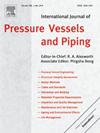Failure mechanisms of fusion-bonded reinforcement joints in reinforced thermoplastic pipes under uniaxial tensile conditions
IF 3
2区 工程技术
Q2 ENGINEERING, MECHANICAL
International Journal of Pressure Vessels and Piping
Pub Date : 2024-11-13
DOI:10.1016/j.ijpvp.2024.105359
引用次数: 0
Abstract
As deep-sea oil and gas extraction technologies advance, the demand for high-performance joints in reinforced thermoplastic pipes (RTPs) has increased. This study introduces a novel fusion-reinforced joint for RTPs and analyzes its tensile failure mechanism. Two user-defined material (VUMAT) subroutines were developed for unidirectional fiber composites and plain fabric composites to analyze the damage of RTPs and joints. The tensile damage mechanisms were evaluated using the 3D Hashin failure criterion, the maximum strain failure criterion, the residual stiffness model, and the cohesive zone model (CZM). To validate the numerical model, fusion-reinforced joints were designed, machined, and subjected to uniaxial tensile tests. Findings suggest that matrix damage in RTPs is the primary factor contributing to stiffness degradation. The shear stress in the adhesive layer at both ends of the joint reaches the shear strength, resulting in the failure of the adhesive. The tensile process can be divided into four distinct stages: the no-damage stage, the bonding damage stage, the matrix damage stage, and the failure stage. Initially, damage in the adhesive layer leads to a minor decrease in tensile stiffness, followed by significant matrix damage in the RTPs. Failure of the adhesive layer at both ends of the joint gradually propagates to the middle, culminating in the failure of the fusion zone. The time required to reach maximum strain in the central joint region is longer than at the ends.
单轴拉伸条件下增强热塑性塑料管道中熔融粘接加固接头的破坏机理
随着深海油气开采技术的发展,对增强热塑性塑料管(RTP)高性能接头的需求也在增加。本研究介绍了一种用于 RTP 的新型熔融增强接头,并分析了其拉伸失效机理。针对单向纤维复合材料和普通织物复合材料开发了两个用户自定义材料(VUMAT)子程序,用于分析 RTP 和接头的损坏情况。使用三维哈辛破坏准则、最大应变破坏准则、残余刚度模型和内聚区模型(CZM)对拉伸破坏机制进行了评估。为了验证数值模型,对熔融加固接头进行了设计、加工和单轴拉伸试验。研究结果表明,RTP 中的基体损伤是导致刚度下降的主要因素。接头两端粘合剂层中的剪应力达到剪切强度,导致粘合剂失效。拉伸过程可分为四个不同阶段:无损坏阶段、粘接损坏阶段、基体损坏阶段和失效阶段。最初,粘合剂层的损坏导致拉伸刚度轻微下降,随后 RTP 中的基质发生明显损坏。接头两端粘合层的破坏逐渐向中间扩展,最终导致融合区的破坏。在接头中心区域达到最大应变所需的时间比两端长。
本文章由计算机程序翻译,如有差异,请以英文原文为准。
求助全文
约1分钟内获得全文
求助全文
来源期刊
CiteScore
5.30
自引率
13.30%
发文量
208
审稿时长
17 months
期刊介绍:
Pressure vessel engineering technology is of importance in many branches of industry. This journal publishes the latest research results and related information on all its associated aspects, with particular emphasis on the structural integrity assessment, maintenance and life extension of pressurised process engineering plants.
The anticipated coverage of the International Journal of Pressure Vessels and Piping ranges from simple mass-produced pressure vessels to large custom-built vessels and tanks. Pressure vessels technology is a developing field, and contributions on the following topics will therefore be welcome:
• Pressure vessel engineering
• Structural integrity assessment
• Design methods
• Codes and standards
• Fabrication and welding
• Materials properties requirements
• Inspection and quality management
• Maintenance and life extension
• Ageing and environmental effects
• Life management
Of particular importance are papers covering aspects of significant practical application which could lead to major improvements in economy, reliability and useful life. While most accepted papers represent the results of original applied research, critical reviews of topical interest by world-leading experts will also appear from time to time.
International Journal of Pressure Vessels and Piping is indispensable reading for engineering professionals involved in the energy, petrochemicals, process plant, transport, aerospace and related industries; for manufacturers of pressure vessels and ancillary equipment; and for academics pursuing research in these areas.

 求助内容:
求助内容: 应助结果提醒方式:
应助结果提醒方式:


